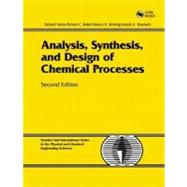
(NOTE: Each chapter concludes with a Summary.)
Preface.
List of Nomenclature.
0. Outcomes Assessment.
SECTION 1. CONCEPTUALIZATION AND ANALYSIS OF CHEMICAL PROCESSES.
SECTION 2. ENGINEERING ECONOMIC ANALYSIS OF CHEMICAL PROCESSES.
SECTION 3. SYNTHESIS AND OPTIMIZATION OF CHEMICAL PROCESSES.
SECTION 4. ANALYSIS OF PROCESS PERFORMANCE.
SECTION 5. THE IMPACT OF CHEMICAL ENGINEERING DESIGN ON SOCIETY.
SECTION 6. INTERPERSONAL AND COMMUNICATION SKILLS.
The New copy of this book will include any supplemental materials advertised. Please check the title of the book to determine if it should include any access cards, study guides, lab manuals, CDs, etc.
The Used, Rental and eBook copies of this book are not guaranteed to include any supplemental materials. Typically, only the book itself is included. This is true even if the title states it includes any access cards, study guides, lab manuals, CDs, etc.